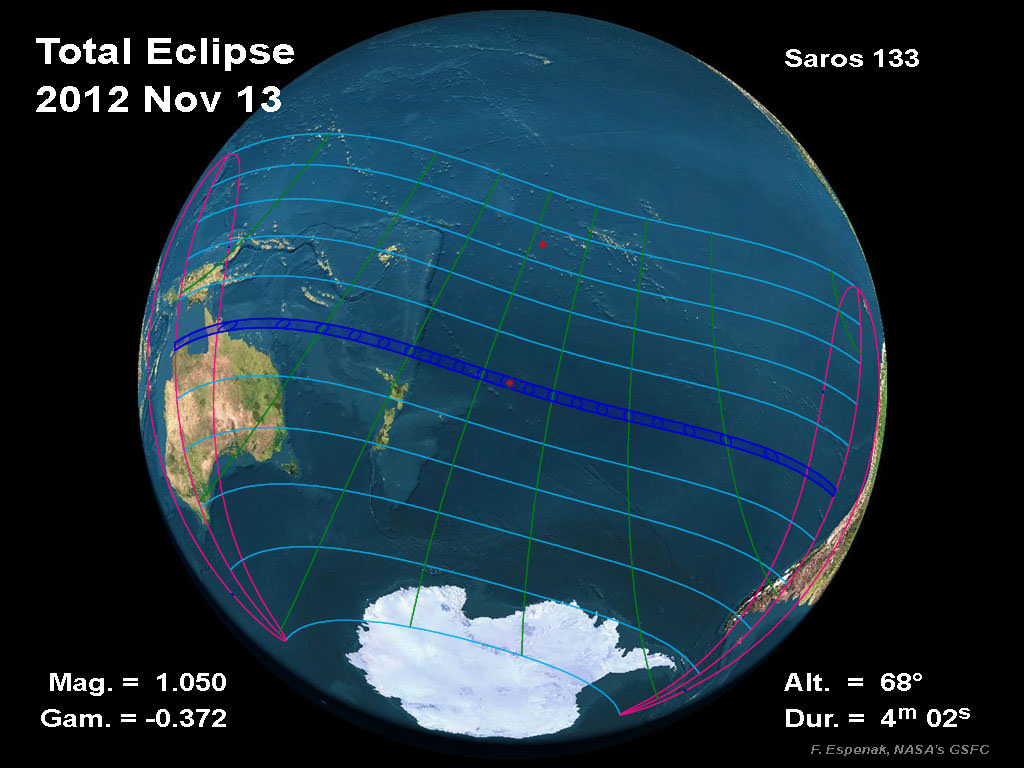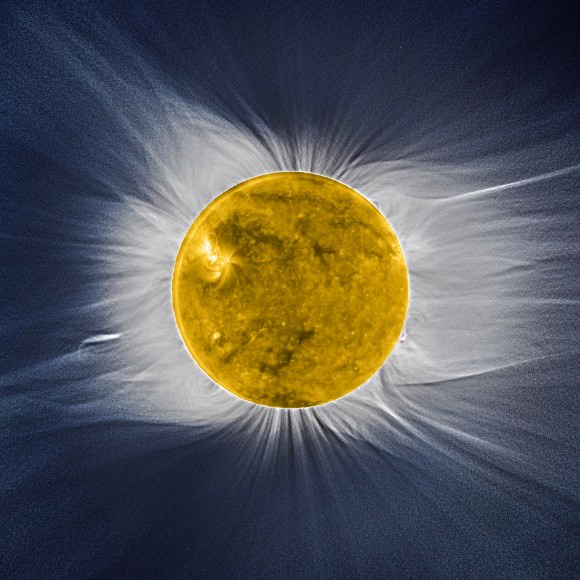Scientists and interested skywatchers have been flocking to Cairns, Australia to witness one of the most spellbinding astronomical sights: a total solar eclipse. The November 13/14 total solar eclipse will only be visible in its entirety to ground-based observers watching from northern Australia, but several webcasts will be available so that people around the world can watch as well. At about 22:11:48 UT on November 13 (it will be the morning of Nov. 14th in Australia) the Moon will pass directly in front of the Sun, and totality will only last about 2 minutes, with the Sun having risen just 14 degrees above the eastern horizon. The total time of the event, from first contact to fourth contact (the end of a solar eclipse when the disk of the Moon completely passes from the disk of the Sun) will be about 3 hours.
During totality the Sun appears to have a white halo – a rare glimpse of the Sun’s million-degree plasma atmosphere, or corona, which is too washed out by the Sun’s brightness to be observed normally.
During an eclipse, “the Moon reveals the innermost corona, which manmade coronagraphs have trouble seeing,” said Shadia Habbal of the Institute for Astronomy in Hawaii, who will be in Australia for the event. “That is where all the magnetic field and physical processes responsible for heating the corona are evolving most rapidly.”
For this total solar eclipse, the path of totality will be about 174 km (108 miles) wide and will cover 14,500 km (9,000 miles) over a 3-hour period.
Below is a list of webcasts for those not in Australia, but an important note if you ARE going to be in an area where you can see the eclipse: DO NOT look directly at the Sun, and especially do not look through a telescope or binoculars at the Sun with your eyes directly. Doing so could cause serious and permanent eye damage. There are special eclipse glasses, or you can make your own eclipse viewers. Mr. Eclipse has a whole list with instructions for pinhole cameras, and other safe viewing methods. If you have a telescope, the folks from Galileoscope have instructions for how to build a Sun-funnel for safe viewing.
Proba-2 image of the solar disc taken during the total eclipse of July 2010, combined with ground-based images taken at the same time to reveal the exquisite details of the solar corona. Credit: ESA
Slooh will be having their webcast at Slooh.com, starting Tuesday, November 13th at 11:30 AM PST / 2:30 PM EST / 19:30 UTC. Viewers can watch the show on their PC or mobile device and will have the ability to ask questions to the Slooh team, including the crew located in Cairns, using the Slooh Conversations section on the Slooh homepage. Viewers will also be able to snap the live pictures directly from the Slooh homepage using Pinterest. The broadcast team includes Patrick Paolucci, Bob Berman, Lucie Green, Matt Francis and Paul Cox.
Another feed will be from the Cairns Eclipse 2012 Ustream channel, broadcast from over Cairns and the Great Barrier Reef, Australia: http://www.ustream.tv/CairnsEclipse2012, and their website is http://www.eclipse2012.org.au
This channel will be live from 11 a.m. PT (2 p.m. ET) on Nov. 13, and 5 am November 14th 2012 (AEST). It is considered the official destination website for the total solar Eclipse over Cairns and Great Barrier Reef will feature Terry Cuttle from the Astronomical Association of Queensland as the host. He will be joined by Kate Russo (eclipse chaser and author), Ben Southall (winner of the ‘Best Job in the World’ promotion and tourism ambassador), Richard Fitzpatrick (an underwater cameraman, will be live from under water) and Alan Hale (from Hale-Bopp comet who is studying comets close to the Sun which can only be seen during an eclipse).
Still another feed will be the Panasonic channel: Broadcast from Sheraton Mirage Port Douglas Resort:
http://www.ustream.tv/channel/panasonic-eclipse-live-by-solar-power-1
Panasonic’s project, described as, “Filming the Sun, using the Sun” aims to capture and broadcast to the world a solar eclipse using only the power of sunlight. They’re using Panasonic’s high efficiency solar power-generating system, “HIT” to generate power with a portable battery back for power storage. They’ll then be able to broadcast the eclipse images captured on a Lumix GH2.
2012 Eclipse live from a Cairns Hot Air Balloon
http://www.hotair.com.au
Up to a dozen hot air balloons floating west of Cairns, Queensland Australia, with visitors from 20 different countries will be part of a live webcast of the 2012 total solar eclipse.
Cairns City Eclipse 2012 webcam
http://www.eclipsecairns.com
Can’t make it to Cairns to see the Eclipse? No problem! Just check back on November 14 before 6:39am AEST (GMT+10) to see it live on their webcam.
GLORIA Project
http://live.gloria-project.eu
Videos and pictures of the eclipse will be broadcast live on the internet starting at 20:30 UT. Additionally meteorological data will be collected to allow students to perform an interactive experiment. During the broadcast there will be live commentary in Spanish and English.
Live Web Camera from Port Douglas Australia 2012
http://www.zincportdouglas.com/solar_eclipse_port_douglas.html
We’ll be embedding a few of the feeds when they go live.



Sweet! Thanks for assembling all of these for those of us who cannot be in totality.